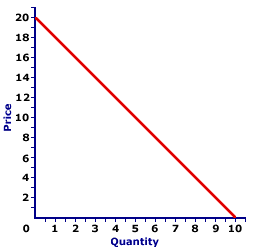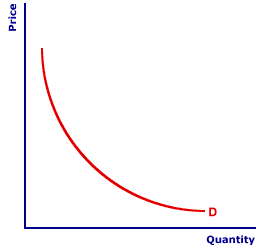The price elasticity of demand is different at each point on a demand curve with constant slope. The reason is that slope and elasticity are different concepts. Slope measures the steepness or flatness of a line in terms of the measurement units for price and quantity. Elasticity measures the relative response of quantity to changes in price.Elasticity Ranges
Consider a quick overview of the relation between elasticity and the slope using this straight-line demand curve for Digital Distance telephone services presented in this exhibit. | Digital Distance Demand |  |
- The price of cellular telephone services is measured in cents per minute on the vertical axis, ranging from 0 to 20.
- The quantity demanded of cellular telephone services is measured in million minutes per month on the horizontal axis, ranging from 0 to 10.
- At the top of the demand curve, buyers are willing to buy 0 minutes of service at 20 cents per minute.
- At the bottom of the demand curve, buyers are willing to buy 10 million minutes of service at 0 cents per minute.
One of the most striking features of this demand curve is that it is a straight line. Being a straight line means the slope is constant. The slope is equal to - 2 cents per million minutes.Moving from the top left of the demand curve (at the intersection with the price axis) to the bottom right (at the intersection with the quantity axis), all five elasticity alternatives exist. Click the [Elasticity] button to reveal the five alternatives.
- The point of intersection between the demand curve and the vertical, price axis is perfectly elastic (E = ∞).
- The intersection point between the demand curve and the horizontal, quantity axis is perfectly inelastic (E = 0).
- The exact middle, or midpoint, of the demand curve is unit elastic (E = 1).
- The segment between the midpoint and the price-axis intercept is relatively elastic (1 < E < ∞).
- The segment between the midpoint and the quantity-axis intercept is relatively inelastic (0 < E < 1).
A Few Calculations
| Digital Distance Demand |  |
To see the source of these elasticity alternatives, consider a few simple calculations using the Digital Distance demand curve to the right and the midpoint elasticity formula below.midpoint
elasticity | = | (Q2 - Q1)
(Q2 + Q1)/2 | ÷ | (P2 - P1)
(P2 + P1)/2 |
Starting near the top, a price change from 5 cents to 6 cents has an elasticity of -0.379. A price change from 10 cents to 11 cents has an elasticity of -1.105. A price change from 14 cents to 15 cents has an elasticity of -2.638. Click the [First Three] button to indicate the segments of the demand curve corresponding to these three values.While these numbers suggest that elasticity is different for different portions of the demand curve, more information would be useful. To display elasticity values for other segments of the demand curve click the [The Rest] button.
At the top of the demand curve, with a price change between 19 and 20 cents, elasticity is -39. At the bottom of the curve, with a price change between 0 and 1 cents, elasticity is -0.026. A brief inspection of the other numbers displayed next to the demand curve clearly indicates that the elasticity values (ignoring the negative sign) grow smaller from the top to bottom--from high prices and small quantities to low prices and large quantities.
Quite clearly that elasticity is NOT constant along this demand curve. In fact, it also seems evident that elasticity is different for every segment on the demand curve. Even though slope is constant for this straight line demand curve, elasticity is most certainly NOT.
The price elasticity of demand is relatively elastic in the upper portion of the demand curve. For segments of the curve that are closer and closer to price axis, as the price is greater and greater and the quantity demanded is less and less, the demand curve is increasingly elastic.
The price elasticity of demand is relatively inelastic in the lower portion of the demand curve. For segments of the curve that are closer and closer to quantity axis, as the quantity demanded is greater and greater and the price is less and less, the demand curve is increasingly inelastic.
The point of intersection between the demand curve and the vertical, price axis is perfectly elastic. The point of intersection between the demand curve and the horizontal, quantity axis is perfectly inelastic. The middle of the demand curve is unit elastic.
An Explanation, Please
Why does a demand curve with constant slope have changing elasticity? An explanation rests with the elasticity concept itself. Elasticity is based on percentage changes in price and quantity. Percentage changes depend on both amount of the change, or the unit change, and the starting point, or base value, of the change. Because slope is constant, unit changes are identical for each segment on the curve. Price changes by 1 cent and quantity changes by 500,000 (0.5 million) minutes in this example.However, the base values are not constant. At the top of the demand curve near the price axis, price is relatively high and quantity is relatively low. A given unit change in price starts from a relatively high base. A given unit change in quantity starts from a relatively low base. As such, the percentage change in price is quite small, while the percentage change in quantity is quite large. This results in a relatively elastic demand.
In contrast, at the bottom of the demand curve near the quantity axis, price is relatively low and quantity is relatively high. A given unit change in price starts from a relatively low base. A given unit change in quantity starts from a relatively high base. As such, the percentage change in price is quite large, while the percentage change in quantity is quite small. This results in a relatively inelastic demand.
Constant Elasticity
| Demand with Constant Elasticity |  |
If a straight-line demand curve has changing elasticity, how would a demand curve with constant elasticity look? It should be evident at this point, that this demand curve CANNOT be a straight line. It IS, in fact, a curve with a changing slope. And the slope changes in a particular manner.For higher prices and smaller quantities, the unit change in price must be larger and the unit change in quantity must be smaller. This results in a steep slope. For lower prices and larger quantities, the unit change in price must be smaller and the unit change in quantity must be larger. This results in a flat slope. As such, the demand curve goes from steep to flat as the price declines and the quantity increases.
The demand curve to the right illustrates the shape needed for constant elasticity.
ELASTICITY AND DEMAND SLOPE, AmosWEB Encyclonomic WEB*pedia, http://www.AmosWEB.com, AmosWEB LLC, 2000-2025. [Accessed: July 18, 2025].


